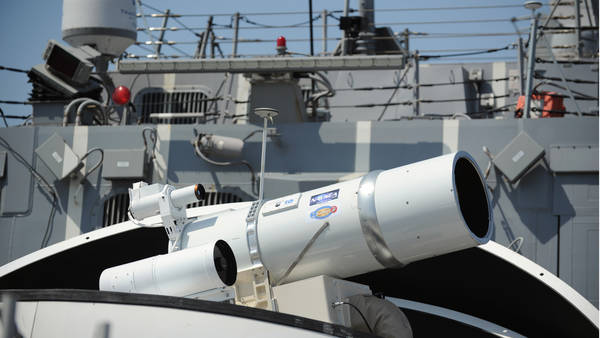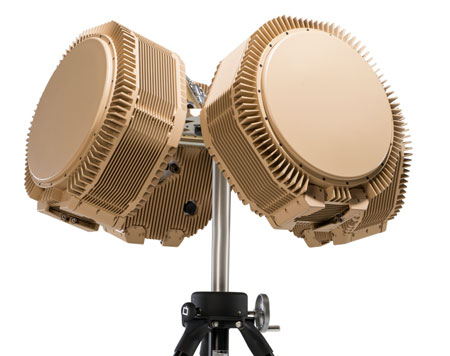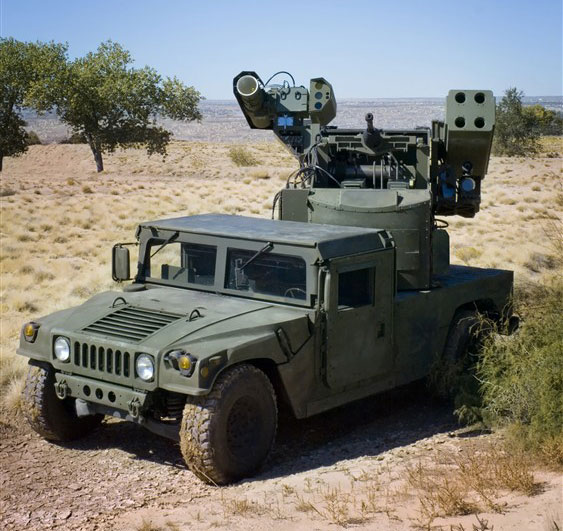
As the Navy prepares to deploy its first laser weapon on a ship later this summer, Office of Naval Research (ONR) officials announced this week that they have finished awarding contracts to develop a similar weapon to be used on ground vehicles.
ONR is working with Naval Surface Warfare Center Dahlgren Division and industry partners on the development of GBAD’s components and subsystems, including the laser itself, beam director, batteries, radar, advanced cooling, and communications and command and control.
“We’re confident we can bring together all of these pieces in a package that’s small enough to be carried on light tactical vehicles and powerful enough to counter these threats,” says Brig. Gen. Kevin Killea, vice chief of naval research and commanding general, the Marine Corps Warfighting Laboratory.
We’re confident we can bring together all of these pieces in a package that’s small enough to be carried on light tactical vehicles and powerful enough to counter these threats
“We can expect that our adversaries will increasingly use UAVs and our expeditionary forces must deal with that rising threat,” says Col. William Zamagni, acting head of ONR’s Expeditionary Maneuver Warfare and Combating Terrorism Department. “GBAD gives the Marine Corps a capability to counter the UAV threat efficiently, sustainably and organically with austere expeditionary forces. GBAD employed in a counter UAV role is just the beginning of its use and opens myriad other possibilities for future expeditionary forces.”
The technologies being developed under the GBAD program are a direct response to the Marine Corps Science and Technology Strategic Plan, which calls for a mobile directed-energy weapon capable of destroying threats such as UAVs.
Some of the system’s components already have been used in tests to detect and track UAVs of all sizes. Later in the year, researchers will test the entire system against targets using a 10kW laser as a stepping stone to a 30kW laser. The 30kW system is expected to be ready for field testing in 2016, when the program will begin more complex trials to ensure a seamless process from detection and tracking to firing, all from mobile tactical vehicles.
The US Navy plans to integrate RADA’s RPS-42 radar system as part of the counter-UAS capability demonstration enabling mobile, ground based laser weapons to defeat small and micro unmanned aerial vehicles. This selection is the second win for RADA’s new radar platform, another system was selected by Boeing to support the High Energy Laser Technology Demonstrator (HEL TD) evaluations, where it has proved highly successful in recent laser intercept tests. Delivery of the system to the US Navy is planned for July 2014.
The Navy’s laser weapon has progressed far enough that when it’s deployed and tested on the USS Ponce this summer the system will be controlled by a single sailor. The solid-state Laser Weapons System would allow the navy to effectively neutralize threats such as airborne UAS and swarm boats.
The program will demonstrate a 50kW class laser weapon, mounted on a tactical vehicle can defeat UAS Low Observable/Low Radar Cross Section (LO/LRCS) threats while on-the-move
The The Ground-Based Air Defense (GBAD) Directed Energy (DE) On-The-Move (OTM) demonstration is part of the Office of Naval Research (ONR) pursuit of future enhancements for the US Marine Corps’ existing low-altitude air-defense capability which currently lacks reliable CounterUAS (C-UAS) and Counter Rocket, Artillery and Mortar (CRAM) capabilities. The Navy currently tests lasers derived from commercial systems, but for the GBAD-DE wants to create lasers which weigh less than 907 kg (2,000 pounds) and can fit entirely into a HMMWV’s or JLTV cargo hold. The laser should pump out a minimum 25 kilowatt beam for a duration for 120 seconds, and recharge to 80% power after only 20 minutes.
The GBAD-DE-OTM program will demonstrate how a 30kW class laser weapon, integrated on a tactical vehicle can defeat such targets on-the-move. The system is designed to defeat Low Observable/Low Radar Cross Section (LO/LRCS) threats such as small UAS. The system designed to provide continuous low altitude air defense will comprise of command and control, sensor, communications and a high energy laser (HEL) weapon. According to the Navy program documents, the radar sensor associated with the system is responsible for air surveillance, target detection and tracking. The identification and threat evaluation are likely to be performed by EO/IR sensors. Once an engagement decision is made, the system performs weapons assignment triggering alert, the laser weapon will then activate briefly to terminate the target. The engagement cycle is completed with kill assessment.
We can expect that our adversaries will increasingly use UAVs and our expeditionary forces must deal with that rising threat

RADA’s RPS-42 Tactical Volume Surveillance Radar System, a member of the company’s Multi-Mission Hemispheric Radar (MHR), was the radar selected to provide those pre-engagement functions. According to the manufacturer, the radar detects, tracks and classifies micro and mini UAS (Groups 1&2) at ranges of up to 10km, accurately tracking the threats up to very high elevation angles.

The MHR is an S Band, Software-Defined, Pulse-Doppler, Active Electronically Scanned Array (AESA) radar, a GaN based digital radar platform using beam forming capabilities and advanced signal processing. The system can be programmed to support multiple missions on each radar platform, for example, combining C-UAS and C-RAM operational missions on the same radar, thus delivering organic, tactical surveillance solutions for force protection systems.
In addition, the system can also monitor low-level traffic air throughout the local airspace, by tracking other aerial targets, including fighter jets and transport aircraft, helicopters, etc. These functions help coordinating low-level air operations supporting the land forces.
The ability to detect and track exceptionally small, low and slow-flying UAS – categorized as significant tactical threats to manoeuvre forces – is challenging conventional radar systems. Advanced VSHORAD systems, especially those based on directed energy, require compact tactical radars that are able to detect these and other threats, operate on-the-move, and provide vital real-time threat information to the fire control system. “All these critical capabilities were designed into the RPS-42 system – delivering volume surveillance and detection of multiple threat types, including the smallest threats.” Zvi Alon, RADA’s CEO explained.



















